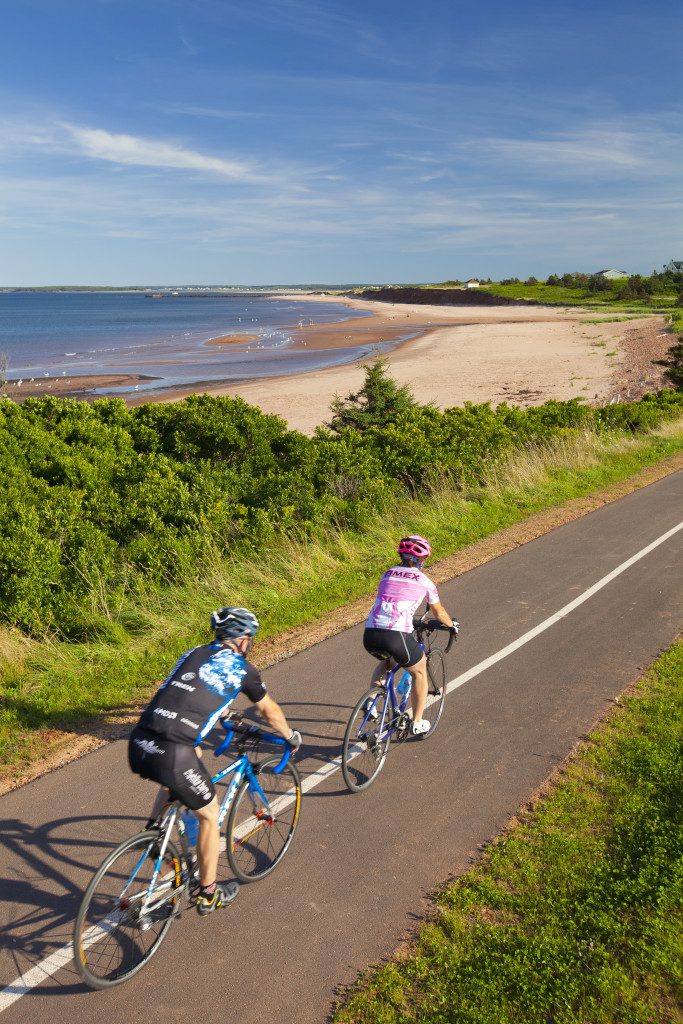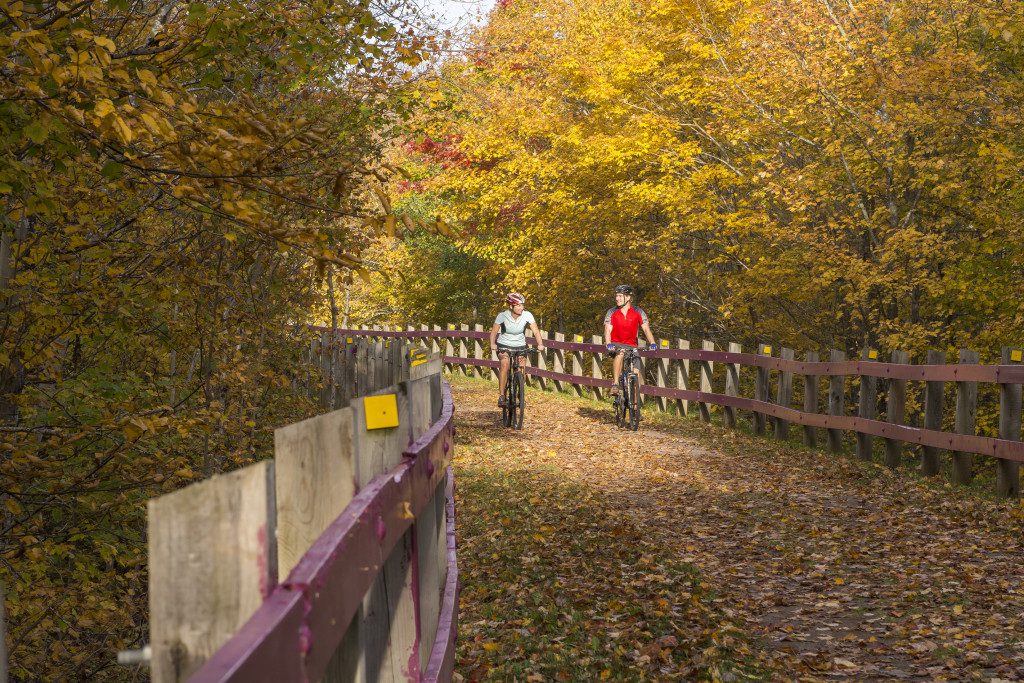P.E.I.’s cycling microcosm
Road riding, singletrack and recreational trails – the island has it all

by Jeff Bartlett

Prince Edward Island might be Canada’s smallest province, but it packs plenty of stunning landscapes – from dramatic coastal cliffs to rolling green farmland – into a small area.
“Leave Charlottetown and break off onto Route 19 in Cornwall,” says Outer Limit Sports owner Brett Doyle, “and just follow the south coast. You’ll see the big red cliffs p.E.I. is known for. You can loop back on any of the roads, but after about 60 km, you’ll have some of the best views of the Confederation Bridge.”
Listening to Doyle list off his favourite rides, which stretch across in all directions like an ad hoc network designed to connect his downtown Charlottetown store to every corner of the province, it’s easy to assume p.E.I. was built for cyclists. It’s just hard to decide which type of bike is best for exploring.
“Plenty of our roads don’t have shoulders,” Doyle admits, “but typically the speed limits and the traffic volumes are so low, nobody ever has a problem. Many of our most popular rides take in a mix of road and trail, which is ideal on a ’cross or hybrid bike, but there is even some fantastic mountain biking.”
As the largest city and provincial capital, Charlottetown is the basecamp for most visitors. After all, from downtown, it’s a relatively short drive to any attraction on the island: Anne of Green Gables’ house is 35 minutes northwest; Greenwich, the eastern terminus of p.E.I. National Park, is 55 minutes northeast; and both the easternmost point (East Point Lighthouse) and westernmost community (Norway) are less than two hours away.
Like much of the island, the city thrives on tourism during the summer months. The common characteristics of island life – a laidback atmosphere and super friendly locals – are visible throughout the city and clear across the island.
Charlottetown is built around the waterfront. It’s in this city that the island’s history connects directly with the rest of Canada. Only a few short blocks separate Confederation Landing Park and Province House, where the Charlottetown Conference was held. Those meetings in Province House were instrumental in the formation of Canada. You can learn about this period in history through a formal walking tour, or by seeing the sites yourself.
A little farther away is the Rodd Charlottetown hotel, a luxury hotel built by Canadian National Railway to spur tourism on the island in the 1930s. The island’s railway system has been removed, but it’s far from forgotten.
“It’s easy to assume P.E.I. was built for cyclists. It’s just hard to decide which type of bike is best for exploring.”
It’s been replaced by the multi-use Confederation Trail, which runs tip to tip across p.E.I. and connects many of the well-known landmarks along its 273-km length. The entire route is a popular four-to-eight-day end-toend bike tour, with multiple companies offering daily luggage transfers and pickup/dropoff services from both ends of the trail. The trail also helps connect some of Charlottetown’s best day rides, including scenic rides to two sections of Prince Edward Island National Park, Dalvay by the Sea and Greenwich.
“The most popular ride we recommend takes cyclists from downtown Charlottetown to York, along the Confederation Trail,” Doyle says. “From there, it’s Route 25 that heads directly into p.E.I. National Park. In the park, you can ride the paved parkway along the ocean or a great bike path that goes along the ocean, too, and through sand dunes. Eventually, you arrive at Robinsons Island.”
Robinsons Island, which would be the turnaround point on Doyle’s suggested ride, is where cycling on p.E.I. focuses on singletrack. “Parks Canada put in a mountain bike trail,” explains Cycling pEI director Mike Connolly, “and we stepped in to develop the technical features and a pump track.”

It’s just one of three major Cycling pEI projects. The province-wide cycling group has seen its membership quadruple in the past five years thanks to its initiatives running community events, working with appropriate government ministries and, of course, giving cyclists new trails to ride.
“The trails are rocky and rooty. It’s really suitable for intermediate and advanced riders.”
The largest mountain bike trail network is just a half-hour drive from Charlottetown, at the Brookvale Nordic Centre. Cycling pEI has built up more than 15 km of singletrack, which loops in and out of the existing cross-country ski trails. “We’ve done a lot of work on those trails,” Connolly says, “so there are lots of berms and some really technical features. The trails are rocky and rooty. It’s really suitable for intermediate and advanced riders.”
In nearby Bonshaw, which is actually a little closer to Charlottetown, another trail network is being developed. A controversial highway-realignment project left the government scrambling to put a positive spin on leftover expropriated land, so a new provincial park was created. Cycling pEI got involved and began work on an extensive mountain bike park that will eventually link together multiple provincial parks. Although there are already 15 km of trails, the current plans push that number closer to 50 km in the next few years. “It’s just another example of the diversity of our trail networks,” he says. “We have the full gamut, from quality XC singletrack right down to the smooth Confederation Trail.”
Doyle also points out that the road riding is as challenging as it is scenic. “It always gets people,” Doyle says, “because they expect a flat ride. There are some gradual never-ending climbs. But we’re on an island, so we have lots of wind and it’s always in your face. The rides here are as challenging as anywhere.”

Details
How to get there Charlottetown sees daily flights to and from Halifax, Montreal and Toronto with both Air Canada and Westjet. For land-based arrivals and departures, the Confederation Bridge connects to the mainland near Moncton, N.B., while ferries connect to Nova Scotia. Both services charge a fee upon departure. The bridge toll begins at $45.50, while ferries begin at $70.00.
Where to stay
Both the Rodd Charlottetown (roddvacations.com/rodd- charlottetown) and The Great George (thegreatgeorge.com) provide luxury accommodation, while also speaking to the capital city’s rich history. Chain hotels, including everything from Best Westerns to Super 8s are available, meaning there is an option for nearly any budget.
Camping is popular across the island, too, and the Cornwall KOa (koa.com/campgrounds/cornwall) is the closest campground to the city.
Where to eat
Seafood rules Prince Edward Island and Doyle always recommends cyclists stop at either Rick’s Fish’n’Chips in St-Peters Bay (ricksfishnchips.com) or Richard’s Fresh Seafood in Stanhope (richardsfreshseafood.com) while on their rides. In Charlottetown, keep it simple at either The Chip Shack (4 Prince St.) for tasty fish ’n’ chips or Dave’s Lobster (daveslobster.com) for lobster rolls. For a sit-down meal, the Water Prince Corner Shop and Lobster Pound (waterprincelobster.ca), Claddagh Oyster House (claddaghoysterhouse.com) and Gahan House brewery pub (charlottetown.gahan.ca) are all equally popular with locals and visitors.
Where to shop
Charlottetown’s two leading bike shops – Outer Limit Sports (ols.ca) and MacQueen’s Bike Shop (macqueens.com) – are located less than five minutes apart in the downtown centre.
What to do off the bike
Take in the famous Anne of Green Gables – The Musical at the Confederation Centre of the Arts; swim in the Atlantic at Cavendish Beach in P.E.I. National Park or in Northumberland Strait at Argyle Shore Provincial Park; visit Summerside, the island’s second largest city, and dive into its rich Acadian history; or get out on the water in a kayak or on a lobster fishing boat.
